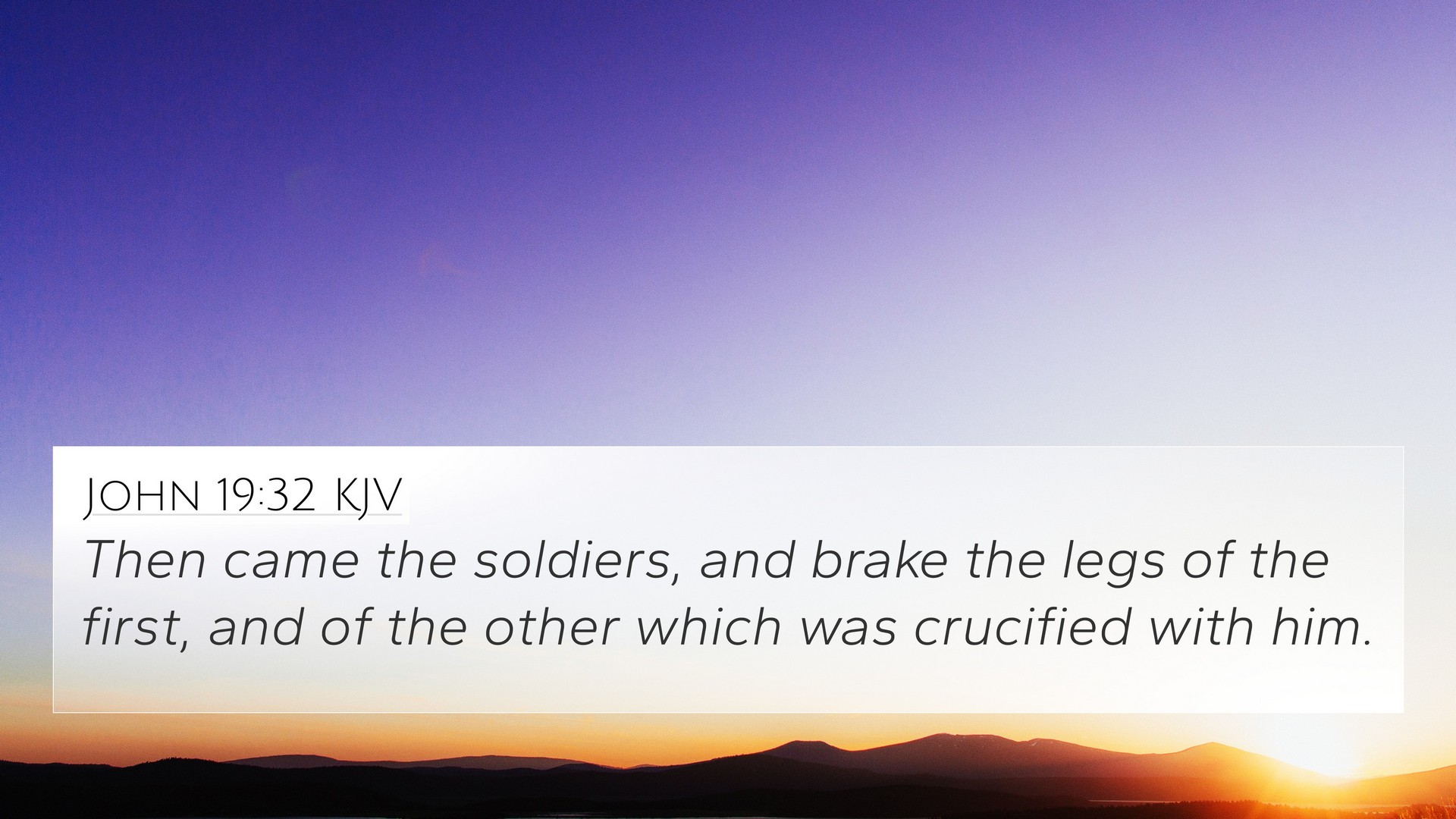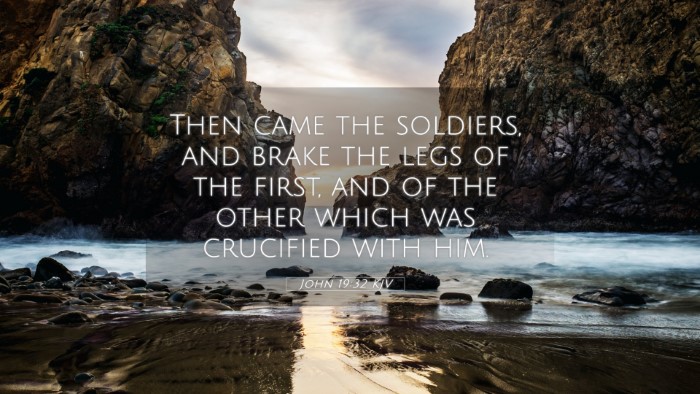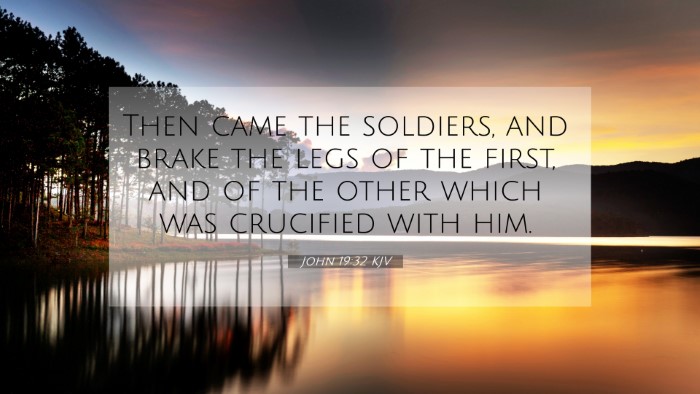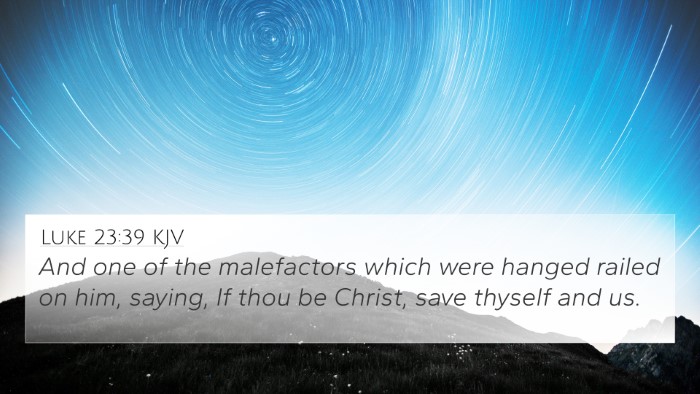Understanding John 19:32
In the Gospel of John, chapter 19, verse 32, we see a significant moment in the crucifixion narrative:
"Then came the soldiers, and brake the legs of the first, and of the other which was crucified with him."
This event carries profound meanings and connections, particularly in the context of prophecy and fulfillment, linking it to various themes throughout the Scriptures.
Contextual Overview
This verse takes place during the crucifixion of Jesus Christ. As the day of preparation for the Sabbath was approaching, the Jewish leaders sought to ensure that the bodies of the crucified did not remain on the cross during the Sabbath. According to Jewish law, bodies were to be taken down before evening of the Passover (Deuteronomy 21:22-23).
The soldiers were commanded to break the legs of the crucified men to hasten their deaths. Breaking the legs would immobilize the victims, preventing them from pushing themselves up to breathe, thereby leading to death by asphyxiation.
Commentary Insights
-
Matthew Henry:
Henry highlights that this action fulfilled the requirement of not allowing the bodies to remain on the crosses during the Sabbath. He draws parallels between the act of breaking the legs and the utter contempt shown by the Roman soldiers towards those who were crucified—a reflection of the brutality of the crucifixion. Furthermore, he notes the symbolic act of breaking the legs: it is contrary to the prophetic nature of the Lamb of God, who is without broken bones (Exodus 12:46).
-
Albert Barnes:
Barnes emphasizes the fulfillment of Scripture in this moment, contrasting it with the prophecy found in Psalm 34:20, which states that the “bones of the righteous” will not be broken. This serves as a reminder that even amid extreme human cruelty, God’s plan was being fulfilled, showcasing the divine orchestration behind the events of the crucifixion.
-
Adam Clarke:
Clarke focuses on the military context, explaining that the actions of the Roman soldiers were a standard procedure. Moreover, he remarks on the prophetic significance of Jesus' unbroken bones which points to His purity and innocence. Clarke relates this directly to the portrayal of Jesus in the overall biblical narrative as the ultimate sacrificial lamb.
Cross-References and Thematic Connections
John 19:32 is deeply intertwined with various themes and prophetic references throughout the Bible. Here are some noteworthy cross-references:
- Exodus 12:46 - This verse discusses the Passover lamb and stipulates that none of its bones shall be broken, establishing a typological link between Jesus and the sacrificial lamb.
- Psalm 34:20 - A prophetic Psalm that states the Lord protects all His bones, alluding to the protection of the Messiah during crucifixion.
- John 1:29 - John the Baptist identifies Jesus as the Lamb of God who takes away the sins of the world, establishing His sacrificial purpose.
- 1 Corinthians 5:7 - Paul refers to Christ as our Passover, emphasizing the typology of Jesus as the unblemished sacrifice.
- Luke 23:46 - Jesus’ final words, “Father, into your hands I commit my spirit,” confirm His completeness and the fulfillment of the law and prophecies.
- Matthew 27:35 - This verse recounts the soldiers casting lots for Jesus' garments, which correlates with Psalm 22:18 and underscores the significance of His suffering.
- Mark 15:44-45 - Here, Joseph of Arimathea requests Jesus’ body, further interlinking the narratives about the treatment of Jesus’ body post-crucifixion.
Connections between Bible Verses
The connections between John 19:32 and other scripture are not merely coincidental. They serve to establish a cohesive narrative about the sacrificial nature of Jesus and His fulfillment of Old Testament prophecies.
By referencing the prophetic verses, we can see the thematic elements of sacrifice, redemption, and the purity of Christ become clearer. The breaking of the legs serves as a physical act that contrasts with Jesus’ nature as the sinless offering for humanity's transgressions.
Bible Verse Parallels
Understanding John 19:32 also benefits from a comparative analysis with other Bible verses that convey similar themes. Notably:
-
John 19:33 - "But when they came to Jesus, and saw that he was dead already, they brake not his legs;" This verse directly follows John 19:32 and emphasizes the miraculous nature of Jesus’ death where His bones remained unbroken.
-
Hebrews 9:12 - This verse showcases Christ entering the holy place “with his own blood” and establishes Him as the ultimate sacrifice, connecting again back to the themes of the sacrificial lamb.
Application and Reflection
For readers and believers today, John 19:32 invites reflection on themes of sacrifice, obedience to God's law, and the implications of Christ's suffering. The unbroken bones of Jesus signify His perfection as the sacrificial lamb and affirm His identity as the Messiah, providing hope and assurance to all who believe.
By engaging in cross-referencing Bible studies, believers can deepen their understanding of scriptures and their interconnectedness, promoting a comprehensive view of God’s redemptive plan through Christ.
Conclusion
John 19:32 is not merely a historical account but a profound theological statement that reinforces the integrity of God’s plan. It serves as a reminder of the depth of Christ’s sacrifice and the fulfillment of the prophecies laid before. Through studying such verses in conjunction, we gain richer insights into our faith and the narrative woven throughout the Scriptures.




